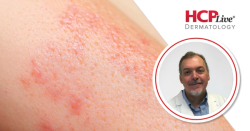
OR WAIT null SECS
Breaking Down Vitiligo Misconceptions at SDPA 2025, With Gina Mangin, PA-C
At SDPA 2025, Mangin discussed her vitiligo approach, misconceptions, and how to determine when the disease is active.
At the 2025 Society of Dermatology Physician Assistant (SDPA) annual summer meeting on Thursday, June 26th, in Washington, DC, Gina Mangin, MPAS, PA-C, from Sand Lake Dermatology Center, presented “Vitiligo in Practice: Clinical Insights and Management Supported by Incyte.”
During an on-site interview with HCPLive at the meeting, Mangin discussed her approach to treating vitiligo, particularly in patients with skin of color.
“I use my wood lamp every single time I have a patient that comes in with any type of concern, where it's white spots or discoloration,” Mangin said. “Years prior, I may have thought, ‘Oh, I can make this diagnosis of vitiligo without the Woods lamp.’ No, a Woods lamp is essential to evaluating your patients for vitiligo.”
She also addressed a common vitiligo misconception, which is that no treatment exists for vitiligo. A misconception patients often have is that since they have had this condition for years, it will not re-pigment. It does not matter if a patient has had vitiligo for 2 years or 20 years—there is still potential to re-pigment the skin.
“So, when I have patients coming into the office now, I'm excited, because we have FDA-approved medications for them,” Mangin said.
Alongside the gold standard of using narrowband UVB for vitiligo, new medications will reach the market soon.
Mangin determines a systemic therapy over a topical or phototherapy if the disease is active. Markers for an active disease include a 1% increase in body surface area within 4 weeks, confetti-style depigmentation, an active Kebner phenomenon or trichome, or an inflammatory border around the vitiligo.
She noted that some areas are harder to pigment, including the hand, feet, and ankles, because of the lack of hair follicles. In this case, she may prescribe a topical along with phototherapy to really help with the re-pigmentation.
“We want to stop that autoimmune attack against the melanocytes,” Mangin said. “We want to re-pigment the skin, and we want to maintain that pigmentation. So that's usually where the aggressive approach is going to come into play, where I am going to use topicals, narrow band, and then, for the active disease patients, those systemics as well.”
References


